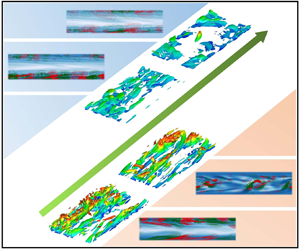Article contents
Maximum drag reduction state of viscoelastic turbulent channel flow: marginal inertial turbulence or elasto-inertial turbulence
Published online by Cambridge University Press: 31 March 2023
Abstract

The essence of the maximum drag reduction (MDR) state of viscoelastic drag-reducing turbulence (DRT) is still under debate, which mainly holds two different types of views: the marginal state of inertial turbulence (IT) and elasto-inertial turbulence (EIT). To further promote its understanding, this paper conducts a large number of direct numerical simulations of DRT at a modest Reynolds number Re with  $Re = 6000$ for the FENE-P model that covers a wide range of flow states and focuses on the problem of how nonlinear extension affects the nature of MDR by varying the maximum extension length
$Re = 6000$ for the FENE-P model that covers a wide range of flow states and focuses on the problem of how nonlinear extension affects the nature of MDR by varying the maximum extension length  $L$ of polymers. It demonstrates that the essence of the MDR state can be both IT and EIT, where
$L$ of polymers. It demonstrates that the essence of the MDR state can be both IT and EIT, where  $L$ is somehow an important parameter in determining the dominant dynamics. Moreover, there exists a critical
$L$ is somehow an important parameter in determining the dominant dynamics. Moreover, there exists a critical  $L_c$ under which the minimum flow drag can be achieved in the MDR state even exceeding the suggested MDR limit. Systematic analyses on the statistical properties, energy spectrum, characteristic structures and underly dynamics show that the dominant dynamics of the MDR state gradually shift from IT-related to EIT-related dynamics with an increase of
$L_c$ under which the minimum flow drag can be achieved in the MDR state even exceeding the suggested MDR limit. Systematic analyses on the statistical properties, energy spectrum, characteristic structures and underly dynamics show that the dominant dynamics of the MDR state gradually shift from IT-related to EIT-related dynamics with an increase of  $L$. The above effects can be explained by the effective elasticity introduced by different
$L$. The above effects can be explained by the effective elasticity introduced by different  $L$ at a fixed Weissenberg number (Wi) as well as the excitation of pure EIT. It indicates that larger
$L$ at a fixed Weissenberg number (Wi) as well as the excitation of pure EIT. It indicates that larger  $L$ introduces more effective elasticity and is favourable to EIT excitation. Therefore, we argue that the MDR state is still dominated by IT-related dynamics for the case of small
$L$ introduces more effective elasticity and is favourable to EIT excitation. Therefore, we argue that the MDR state is still dominated by IT-related dynamics for the case of small  $L$, but replaced by EIT-related dynamics at high
$L$, but replaced by EIT-related dynamics at high  $L$. The obtained results can harmonize the seemingly controversial viewpoints on the dominant dynamics of the MDR state and also provide some ideas for breaking through the MDR limit, such as searching for a polymer solution with a proper molecular length and concentration.
$L$. The obtained results can harmonize the seemingly controversial viewpoints on the dominant dynamics of the MDR state and also provide some ideas for breaking through the MDR limit, such as searching for a polymer solution with a proper molecular length and concentration.
- Type
- JFM Papers
- Information
- Copyright
- © The Author(s), 2023. Published by Cambridge University Press
References
- 6
- Cited by



